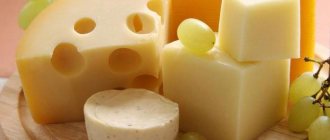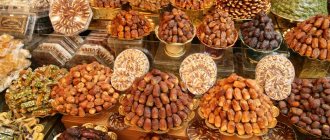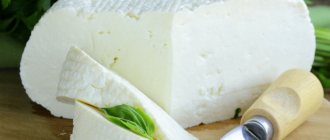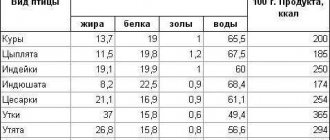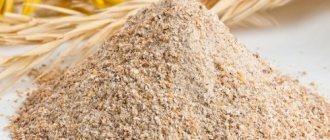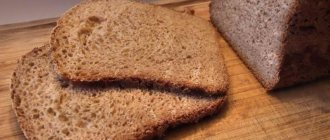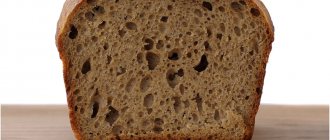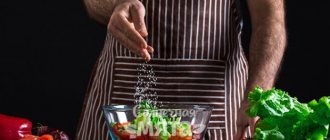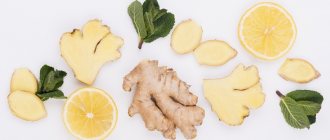Lavash: what does calorie content depend on?
The tradition of baking bread is common to almost all nations. Round flatbreads are an integral dish on the table of residents of the Caucasus and Asia. Delicious pastries quickly gained wide popularity in the world. Today, the product can be bought in any supermarket.
People who adhere to a healthy diet and those who are struggling with excess weight are primarily interested in the question, how many calories are in lavash ? It is impossible to answer this question unambiguously. It all depends on the ingredients used in the recipe.
The classic flatbread consists of only three components - water, flour and sourdough. Spices, including salt, are not used intentionally so as not to interrupt the taste of the main dish with which the bread sheets are served. A product manufactured in accordance with technological standards can be stored for a long time and has a low calorie content.
When yeast, vegetable oil, baking powder, flavor enhancer, cheese or other ingredients are added to the dough, the shelf life of the product is significantly reduced, but the calorie content becomes an order of magnitude higher.
Calorie content of thin lavash
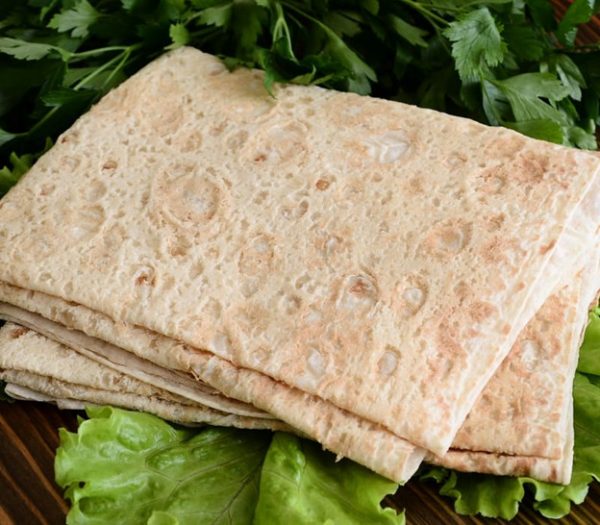
Thin flatbread is the healthiest type of pita bread. It can be served with a hot dish, or used to prepare snacks.
Be sure to read: Table of calorie content of different flours: choosing the most dietary flour for weight loss
To make unleavened baked goods, usually 250 g of wheat flour is taken for half a glass of liquid.
The method of kneading the dough is quite simple:
- boil water, add a little salt;
- pour flour into a deep bowl and make a well in the middle;
- pour liquid into the prepared container in a small stream;
- knead gently until a homogeneous consistency is obtained;
- Wrap the finished dough in transparent film and leave for 25-30 minutes;
- Divide the mass into equal 6-8 parts;
- roll out each piece as thinly as possible;
- Place in a dry frying pan and lightly fry on both sides.
A universal version of bread circles, it goes well with meat, vegetable or berry filling.
The average value of the dish is 220 kcal/100 g. One flatbread (weighing 50 g) contains 100 kcal.
Baking lavash with your own hands
Yeast-free bread is easy to bake at home. To do this you will need:
The recipe for dietary lavash is quite simple:
Fillings
Various dietary fillings are suitable for homemade or store-bought lavash. Here are some options:
Any of the listed fillings can be wrapped in pita bread, giving it the shape of a roll, rectangle or triangle, served whole or cut into small portions.
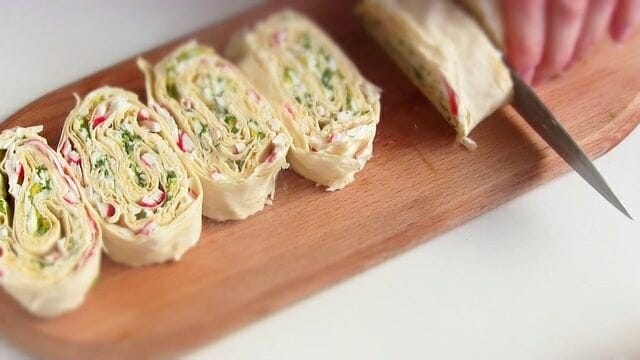
Portion-cut lavash stuffed with vegetables
Calorie content of the product depending on the filling
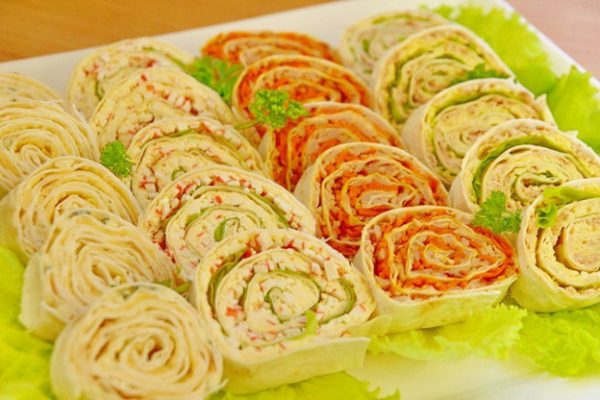
When choosing bread rolls, it is important to consider not only the composition of the dough, but also the content of the product. The most dietary option is considered to be vegetable fillings, while the most high-calorie options are cheese and meat fillings.
Table No. 1 Energy composition of lavash with different types of fillings.
| Flatbread with filling | Kcal. in 1 piece (50-80 g) | BJU ratio | ||
| Belkov | Zhirov | Carbohydrates | ||
| Chicken with cucumbers | 118 | 13 | 0,9 | 12 |
| With cheese and dill | 212 | 11 | 10 | 22 |
| Mushrooms | 198 | 9 | 13 | 12 |
| Red fish | 177 | 11 | 6 | 20 |
| Egg with green onions | 199 | 12 | 8 | 10 |
| With crab sticks | 150 | 6 | 4 | 17 |
| With sausages and grated cheese | 233 | 7 | 13 | 18 |
| Curd | 200 | 12 | 9 | 17 |
| With vegetables | 158 | 8 | 4 | 22 |
| With fruits | 153 | 6 | 2 | 28 |
| Fresh cucumbers and tomatoes | 92 | 5 | 3 | 11 |
Lavash: calorie content per 100 grams
There are two main types of lavash: Armenian and Georgian. Other types of products are made according to almost the same recipes, but with the addition of any additional ingredients.
Table No. 2. Amount of calories per 100 g of product.
| Tite products | Kcal per 100 g |
| Classic Armenian | 236 |
| Cheese flatbread | 261 |
| Georgian | 274 |
| Thin yeast-free | 220 |
| Yeast circle | 280 |
Lavash: calorie content, vitamin composition, beneficial properties

Pita bread, which ranges from 260 to 285 calories, is a traditional Middle Eastern dish. The traditional recipe for Armenian lavash, whose calorie content does not exceed 275 calories, includes only three ingredients: flour, salt, water. The only ingredients allowed in the traditional recipe are roasted sesame or poppy seeds. A distinctive feature of the dish is not only the recipe, but also the cooking technology. Thus, lavash, the calorie content of which does not exceed the calorie content of other types of bread, is baked in a special oven called “tandoor”, without the use of fats and oils.
Lavash is an unleavened flatbread reaching 1 m in length and 40 cm in width. However, modern flatbreads are baked in much smaller sizes for ease of consumption. The weight of one flatbread reaches 200-250 g. Due to its composition, lavash, which is low in calories, can be stored for quite a long time. In Middle Eastern countries, lavash is stored for future use; it is traditionally prepared in September. After baking, the finished cakes are hung individually, dried and stacked. During storage, pita bread dries out, but as soon as you grease the dried flatbread with a small amount of water, the bread becomes soft and fragrant again.
The number of calories in lavash is extremely low, which allows you to use this type of unleavened bread even during strict diets. Nutrient composition of lavash, the calorie content of which does not exceed the calorie content of white bread, per 100 g of product:
- Proteins – 9.1 g;
- Fats – 1.2 g;
- Carbohydrates – 53.5 g.
Lavash, which is relatively low in calories, does not contain yeast impurities, and also contains less fat in comparison with white bread.
The vitamin composition of lavash (calorie content from 260 to 285 calories) is also rich. This type of bread contains B vitamins (B1, B2, B5, B6, B9, PP), as well as vitamins E, K, and choline.
Macroelements in lavash:
- Potassium;
- Calcium;
- Magnesium;
- Sodium;
- Phosphorus.
Microelements in lavash:
- Iron;
- Manganese;
- Copper;
- Selenium;
- Zinc.
Considering how many calories are in pita bread, as well as its vitamin composition, this flour product can be safely included in the diet. However, when choosing a product, you need to pay attention not only to the calories of lavash, but also to the composition indicated by the manufacturer on the packaging. Preference should be given to those varieties of lavash, the calorie content of which ranges from 260-285 calories, and the composition of which does not contain food additives, flavorings and stabilizers.
Lavash, whose calorie content reaches the same level as white bread, contains dietary fiber (2.2 g per 100 g of product), which helps improve digestion. Constant consumption of lavash allows you to stabilize the carbohydrate balance of the body, strengthen the immune system, replenish the vitamin balance, and also reduce weight due to the absence of yeast components in the product. Due to its thin shape, lavash is not subjected to long-term heat treatment, which allows it to preserve the beneficial properties of its components as much as possible.
Lavash can be used as bread, and also as an ingredient for preparing various low-calorie dishes.
Lavash: calorie content of 1 sheet
The nutritional value of 1 serving of a dish will depend on the weight of the product and its calorie content per 100 g.
The exact indicator is calculated using a special formula: the mass of the cake is divided by the number 100 multiplied by the calorie content of the product per 100 g.
Table No. 3. Calorie content of 1 sheet of lavash
| Product tit | Product weight (g) | Kcal 1 pc. |
| Classic Armenian | 80 | 189 |
| Cheese flatbread | 160 | 417 |
| Georgian | 230 | 632 |
| Thin yeast-free | 50 | 120 |
| Yeast circle | 250 | 600 |
If a product is purchased in stores or centralized markets, all the necessary information is usually indicated by the manufacturer on the product packaging.
Nutritional value and calorie content
Lavash is an unleavened, thin flatbread baked from wheat flour, salt, water and a special starter - a piece of raw dough left over from the previous batch of bread. It is baked in the form of a thin oval, round or rectangular pancake.
The dimensions of one leaf reach 40-50 cm in width and 100 cm in length. In the Caucasus, baked lavash is dried, stacked and stored for up to 3-4 months. Before use, the sheet is sprinkled with water and covered with a towel, and after half an hour it becomes as soft as if the bread had just been taken out of the oven.
The historical homeland of lavash is Armenia and Iran - it was in these countries that a special technology for baking thin bread was developed. Even in ancient times, unleavened flatbreads became popular among all the peoples of the Caucasus, Western Asia, the Mediterranean and the Middle East.
The calorie content and ratio of BZHU lavash depends on the characteristics of the raw materials, the characteristics of baking and the composition of the fillings. Nutritional value data per 100 g of product is given in the table:
Calorie content of Armenian lavash
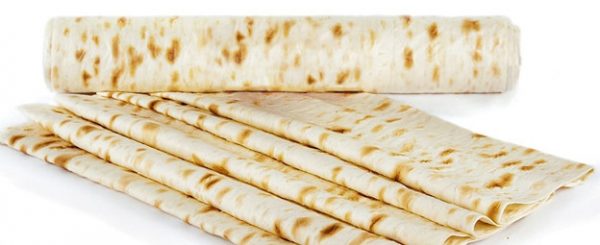
The Armenian variety is considered the most dietary and light snack. Baking prepared according to all traditions does not contain any additional ingredients except flour, water and salt.
Simple composition, contains many useful vitamins of group PP, A, B and nutrients: phosphorus, chlorine, sodium, selenium, magnesium. Lenten flatbread is suitable even for those who are on a diet.
One hundred grams of Armenian lavash contains no more than 235 kcal.
How many calories are in different types of pita bread?
Table No. 4. Types of pita bread.
| Name | Product weight | Kcal/per 100 g. |
| Thin | Used to prepare savory and sweet snacks. | 220 |
| Armenian | Suitable for replacing regular bread. | 235 |
| Georgian (with added yeast) | Quite a lush and voluminous circle. Served with various sauces. | 275 |
| Caucasian circle | Used as an independent dish. | 262 |
| Gözleme (Turkish flatbread) | Often baked with kefir. Prepared for breakfast or for the dinner table. | 240 |
Is it possible to eat lavash while losing weight?
The most suitable for a dietary diet is the thin type of bread circle. The product improves the functioning of the gastrointestinal tract, has good digestibility, ensures stabilization of the carbohydrate balance in the body and has an acceptable calorie content. Such baking will not harm your health.
However, in order to benefit from flour snacks, you must adhere to a number of recommendations:
- give preference to products based on yeast-free dough;
- consume no more than 2 servings per day (250-300 g);
- do not replace bread rolls with your main meal;
- choose low-fat, light foods as fillings (mushrooms, vegetables, chicken, cottage cheese);
- If possible, prepare the dish yourself, using only low-calorie and healthy ingredients.
If you follow a few simple principles, you can eat deliciously without worrying about your figure.
What are the benefits of lavash
The benefit of lavash is that it is considered one of the best types of dietary food. It contains no additives and a large amount of useful substances. If we compare the benefits and harms of thin pita bread, then the harm that it can bring relates rather to the entire way of life. A large amount of carbohydrates without physical activity is generally harmful to the body. And it doesn’t matter that the source of their supply was lavash or another product. Do not forget that lavash and its composition relates, first of all, to unleavened bakery products.
Armenian lavash contains a lot of fiber, which helps remove waste and toxins from the body. Georgian lavash is able to regulate carbohydrate balance in the body. Despite the yeast in its composition, this product does not cause obesity.
But you should understand that only bread that has been prepared according to the correct recipe and has not been frozen will be truly healthy.
